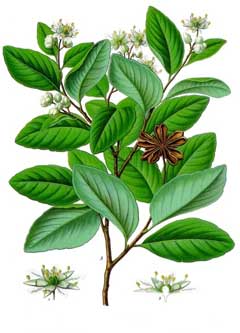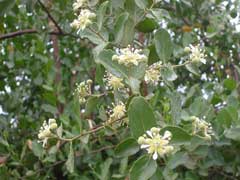 |
|
http://commons.wikimedia.org/wiki/File:Koeh-119.jpg |
 |
| http://commons.wikimedia.org/wiki/User:Penarc |
Translate this page:
Summary
Physical Characteristics

 Quillaja saponaria is an evergreen Tree growing to 18 m (59ft) by 6 m (19ft) at a slow rate.
Quillaja saponaria is an evergreen Tree growing to 18 m (59ft) by 6 m (19ft) at a slow rate.
See above for USDA hardiness. It is hardy to UK zone 10 and is frost tender. It is in leaf all year, in flower from April to May. The species is hermaphrodite (has both male and female organs) and is pollinated by Insects.
Suitable for: light (sandy), medium (loamy) and heavy (clay) soils and prefers well-drained soil. Suitable pH: mildly acid, neutral and basic (mildly alkaline) soils. It cannot grow in the shade. It prefers moist soil.
UK Hardiness Map
US Hardiness Map
Synonyms
Plant Habitats
Woodland Garden Secondary; Sunny Edge; South Wall. By. West Wall. By.
Edible Uses
References More on Edible Uses
Medicinal Uses
Plants For A Future can not take any responsibility for any adverse effects from the use of plants. Always seek advice from a professional before using a plant medicinally.
Antiseborrheic Expectorant Skin Stimulant
Soap bark tree has a long history of medicinal use with the Andean people who used it especially as a treatment for various chest problems[254]. The saponin content of the bark helps to stimulate the production of a more fluid mucous in the airways, thus facilitating the removal of phlegm through coughing[254]. The tree is useful for treating any condition featuring congested catarrh within the chest, but it should not be used for dry irritable coughs[254]. The inner bark contains about 9% of complex saponins, known collectively as 'quillajasaponin'[238]. It also contains calcium oxalate and tannin[238]. It has been used internally as a stimulating expectorant, though it can cause irritation and inflammation of the digestive tract and so is no longer considered safe[4, 238]. The internal use of this plant needs to be carefully overseen by a professional practitioner[254]. Sap bark tree is used as a source of compounds for the pharmaceutical industry[238]. It is still used externally as a cutaneous stimulant in the treatment of skin ulcers and eruptions, dandruff etc[171, 238].
References More on Medicinal Uses
The Bookshop: Edible Plant Books
Our Latest books on Perennial Plants For Food Forests and Permaculture Gardens in paperback or digital formats.

Edible Tropical Plants
Food Forest Plants for Hotter Conditions: 250+ Plants For Tropical Food Forests & Permaculture Gardens.
More

Edible Temperate Plants
Plants for Your Food Forest: 500 Plants for Temperate Food Forests & Permaculture Gardens.
More

More Books
PFAF have eight books available in paperback and digital formats. Browse the shop for more information.
Shop Now
Other Uses
Hair Soap
The fresh or dried inner bark is a soap substitute[4, 169, 171]. It contains about 9% saponins and is a very gentle and effective cleaner[169, 171]. It is used for cleaning textiles and the skin[1, 46, 169, 171]. It can also be used as a hair tonic[169, 171]. The saponins are also used in anti-dandruff shampoos and exfoliant cleansers[238]. They are used as a foaming agent in fire extinguishers[238]. The bark also contains considerable quantities of carbonate of lime[1].
Special Uses
References More on Other Uses
Cultivation details
Requires a well-drained fertile soil in a sunny position[200]. Plants are hardy to about -12°c in their natural range in South America[166] but they usually require greenhouse protection in Britain[1]. They can succeed outdoors in the milder areas of this country, often as small shrubs but making a tree in the very mildest areas[166]. The young growth in spring can be damaged by late frosts, so it is best to site the plant in a position sheltered from the early morning sun. This species is cultivated for the saponins in its bark in some warm temperate areas of the world[238].
References Carbon Farming Information and Carbon Sequestration Information
Temperature Converter
Type a value in the Celsius field to convert the value to Fahrenheit:
Fahrenheit:
The PFAF Bookshop
Plants For A Future have a number of books available in paperback and digital form. Book titles include Edible Plants, Edible Perennials, Edible Trees,Edible Shrubs, Woodland Gardening, and Temperate Food Forest Plants. Our new book is Food Forest Plants For Hotter Conditions (Tropical and Sub-Tropical).
Shop Now
Plant Propagation
Seed - sow spring in a greenhouse. Prick out the seedlings into individual pots when they are large enough to handle and grow them on in the greenhouse for at least their first winter. Plant out in early summer and give some protection from the cold for at least their first winter outdoors. Cuttings of fully ripe wood of the current year's growth, November in a frame[238].
Other Names
If available other names are mentioned here
Native Range
SOUTHERN AMERICA: Chile
Weed Potential
Right plant wrong place. We are currently updating this section.
Please note that a plant may be invasive in one area but may not in your area so it's worth checking.
Conservation Status
IUCN Red List of Threatened Plants Status :

Growth: S = slow M = medium F = fast. Soil: L = light (sandy) M = medium H = heavy (clay). pH: A = acid N = neutral B = basic (alkaline). Shade: F = full shade S = semi-shade N = no shade. Moisture: D = dry M = Moist We = wet Wa = water.
Now available:
Food Forest Plants for Mediterranean Conditions
350+ Perennial Plants For Mediterranean and Drier Food Forests and Permaculture Gardens.
[Paperback and eBook]
This is the third in Plants For A Future's series of plant guides for food forests tailored to
specific climate zones. Following volumes on temperate and tropical ecosystems, this book focuses
on species suited to Mediterranean conditions—regions with hot, dry summers and cool, wet winters,
often facing the added challenge of climate change.
Read More
Expert comment
Author
Molina.
Botanical References
200
Links / References
For a list of references used on this page please go here
Readers comment